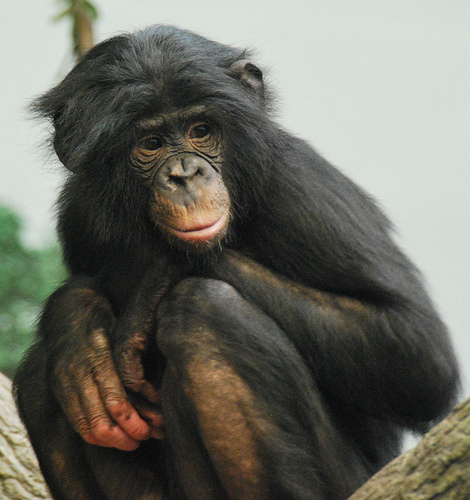A bonobo’s small size does not make it lesser than its great relatives.
- Bonobos are a species of great ape and one of two species in Pan, the chimpanzee genus, and they are native to Africa’s Democratic Republic of the Congo.
- ‘Bonobos’ are also known as ‘dwarf chimpanzees’, ‘pygmy chimpanzees’, and ‘gracile chimpanzees’.
- The scientific name of the bonobo is Pan paniscus, and it is from the family Hominidae, the family of great apes.
- Bonobos stand at a height of approximately 104 to 124 centimetres (41 to 49 inches) and weigh 25 to 61 kilograms (55 to 134 pounds).
- The hair colour of bonobos is dark in colour and can be a combination of brown, black and grey, and while they have a similar appearance to their close relatives, the common chimpanzee, their hair is longer and their exposed skin is typically darker, being almost black.
A Bonobo
Image courtesy of Ted/Flickr
- It is thought that 30,000 to 50,000 individual bonobos exist, and they are listed as endangered, as their numbers have been decreasing, caused primarily by habitat destruction and human hunting for the pet industry, as well as for food.
- Bonobos typically live in small groups of three to ten individuals, often as part of a large community, and they spend time on the ground, as well as in the treetops of rainforests where they make nests of leaves and branches to sleep in, and they are also adept at using tools.
- Individual bonobos generally get along quite well with those in its troop, and there is a social hierarchy where the females are generally more dominant than males, though once mature, female young generally move to another troop; while the social hierarchy of the males is generally dependent on the individual’s mother.
- A bonobo’s diet consists primarily of fruit, but also other parts of plants, as well as eggs and honey, the occasional meat such as small mammals, insects and earthworms.
- Adult female bonobos give birth to one baby every four to five years, and the young are dependent on their mothers for three or more years, and they have a lifespan of 20 to 50 years, reaching the upper limit in captivity.
Bibliography:
Bonobo, 2016, A-Z Animals, http://a-z-animals.com/animals/bonobo/
Bonobo, 2016, San Diego Zoo, http://animals.sandiegozoo.org/animals/bonobo
Bonobo, 2016, Wikipedia, https://en.wikipedia.org/wiki/Bonobo
Williams A, Pan Paniscus, 2004, Animal Diversity Web, http://animaldiversity.org/accounts/Pan_paniscus/






